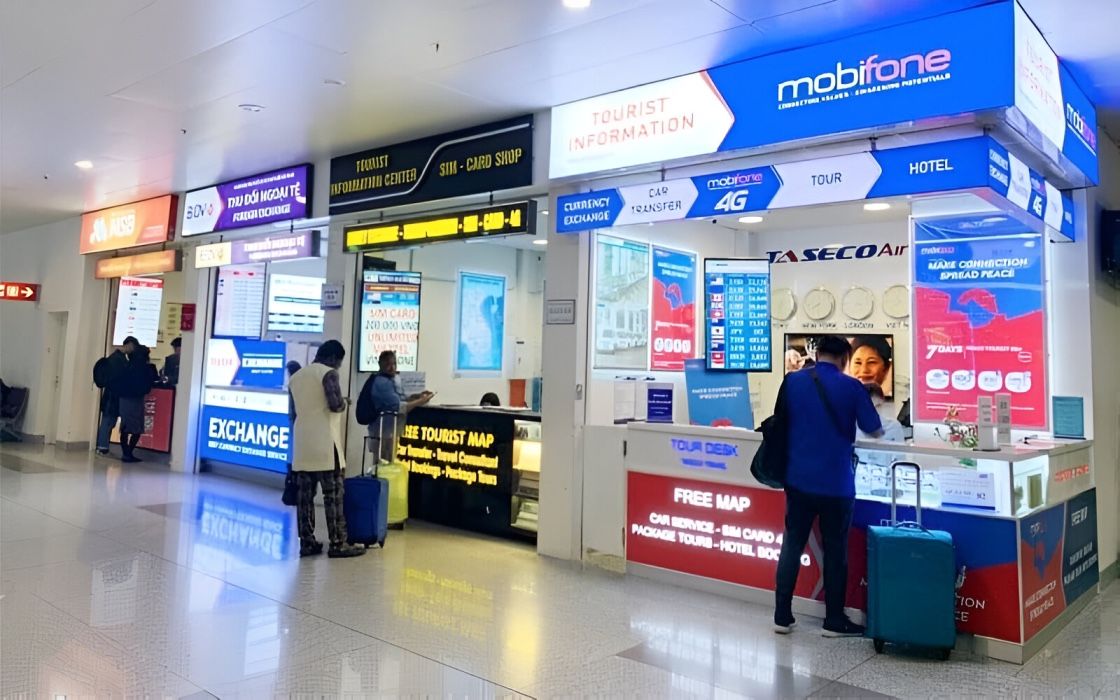Traveler Guide to Vietnam’s Hanoi Noi Bai International Airport
Noi Bai International Airport serves as the main airport for Hanoi, the capital of Vietnam. It is located in Phu Minh, Soc Son, about 30 km north of Hanoi’s city center (The Old Quarter). As one of Vietnam’s busiest airports, it acts as a major hub for domestic and international flights. With the IATA code HAN and ICAO code VVNB, Noi Bai International Airport is Vietnam’s second-largest international airport, alongside Danang International Airport and Tan Son Nhat International Airport in Ho Chi Minh City.
Hanoi Noi Bai International Airport was initially designed to accommodate 10 million passengers annually but now handles an impressive 35 million in January of 2025. Despite the overcrowding, it’s design focuses on functionality. While it may in lack the best modern facilities of airports such as in Singapore, Kuala Lumpur, or Bangkok, it still offers essential amenities and comforts.

Flying into Noi Bai Airport (HAN): What you need to know
Hanoi Airport has separate terminals for domestic and international flights. The domestic terminal manages flights within Vietnam, while the international terminal handles flights to and from other countries.
Passport: Make sure that your passport remains valid for at least six months beyond your travel dates. Apply for or renew it at your local embassy well in advance if needed. if your passport is not valid for at least 6 month beyond your departure date from Vietnam
An E-visa: Check if your nationality requires a visa to enter Vietnam. Many nationalities can apply for an e-visa online. Currently, Vietnam grants visa exemptions to citizens of 25 countries including ASEAN members plus Uk, Italy, Germany, France. For the visa, the BIG BIG tip is to apply well in a head of time and DO NOT relay on 3-5 working days stated on national portal of immigration. Check out Vietnam Visa Requirements in 2025
From August 2023, Vietnam issued with e-visa program to citizens from all countries and territories. Visas available on 1 and 3 month stay. Apply on immigration portal and NOT AT AN EMBASSIES.
Airport review: Hanoi International Airport (HAN)
When you arrive at Hanoi Airport, also called Noi Bai International Airport, you won’t see the ultra-modern designs of airports like in Tokyo or Dubai. Noi Bai is relatively a small airport that emphasizes practicality and maintains a clean, organized environment. While it may lack the luxury of most iconic airports in the world, it effectively manages millions of travelers annually, providing essential services, amenities, and smooth connections for both domestic and international flights.
A very busy Airport: Overcrowding stands out as a major issue at Hanoi Airport. The airport now handles three times its original capacity, highlighting its age and struggles to keep up with the growing arrival passenger.
Departure Sign Board: Signs are both Vietnamese and English to guide passengers upon arrival. The layout remains very simple, though certain areas, especially for international arrivals, require longer walks. While the design lacks simple, it however, stays practical and easy to navigate.
Basic Facilities: Hanoi Airport offers some food and shopping options upon departure, but it doesn’t compare to shopping and dining hubs like in Changi or Tokyo Haneda. The available choices focus more on practicality than excitement, and international travelers may find fewer familiar brands or dining options.
Airport Assistance: Airport staff are helpful and approachable. Although not everyone speaks decent English, most can assist with basic inquiries or direct you to your destination.
Services & Facilities - Hanoi Airport
Airport’s Wi-Fi: Connect to “NoiBaiFreeWiFi,” with a very decent internet speed, once you choose the wifi name, add your phone number to get connected. Easy and very efficient internet provided by Hanoi Noi Bai Airport.
Restrooms: The airport offers plenty of toilets, and they are always clean and neat. Baby-care facilities and accessible restrooms are also available at Hanoi airport, look at the sign to locate them in both domestic and international terminals.
Food, Shopping, and Entertainment: The food scene offers limited options, mainly Vietnamese Pho noodle soup and the Banh Mi (The sandwich), with airport prices, just like everywhere else. A few decent duty-free stores are available, but the selection remains modest.
Passport control & Immigration
At Noi Bai International Airport, Immigration & passport control operates very efficiently. Arrival passengers find separate lines for Vietnamese citizens and foreign passport holders.
During peak hours, the waiting time may be longer, but numerous counters keep the process moving as quickly as possible. Immigration officers review your passport and check your e-visa, they may, may not, asking a few questions about your travel plans, stamp your passport and welcome.
Baggage Claim
Collect your checked luggage (e.g., suitcase) from the baggage carousel. Check your baggage claim ticket to ensure you pick up the correct items. The baggage claim area is very spacious and big enough to accommodate the crowds of travelers.
Waiting time: Bags usually arrive in 15 minutes, though delays can happen, especially after full flights or unloading issues.
Tip: Keep your baggage claim tag ready in case the airport staff approach to check for verification.
After collecting your luggages, head to customs and find the green lane for “Nothing to Declare” and the red lane if you’ve got something to declare (Jewellery, or money in cash). If you’re unsure, feel free to ask the customs staff—most of them are quite helpful, actually if yo have nothing to declare, you can leave and go out of the terminal to get a taxi and travel to city center.
Getting a SIM Card at Hanoi International Airport
Once you done with the customs, you may need a Sim card to use it while traveling in Vietnam. There are a number of stands offer plenty of different services include sim-card from mobile operators like Viettel, MobiFone, and Vinaphone (They are all vendors, not an official provider).
Prices here are slightly higher than in the city, a sim card with 4G internet with basic plans costing around 250,000 VND and more depending on date plan and operator. To pay, credit cards are accepted as well. Also to purchase a sim-card, you’ll need to present your passport and an unlocked mobile phone.
| Operator | SIM Card Type | Price (approx.) | Data Allowance | Validity |
|---|---|---|---|---|
| Viettel | Tourist SIM | $9-15 | 5-15GB | 30 days |
| Vinaphone | Tourist SIM | $6.5-12 | 4-12GB | 30 days |
| Mobifone | Tourist SIM | $5-11 | 3-10GB | 30 days |
Additionally, you can get an e-sim and activate it before arriving in Vietnam. There are various places online selling an e-sim so which the date plans cost from USD10.

ATM / Currency Exchange at Noi Bai airport
Accessing cash at Hanoi Airport is simple since there are dozens of ATMs from local banks like BIDV and Vietinbank, Vietcombank are conveniently located in the arrivals hall, to withdraw Vietnamese Dong (VND).
The ATM exchange rates at Hanoi Airport can be higher than in city, so it’s better to withdraw only a small amount to pay for taxi or maybe a sim-card. Currency exchange counters are also available that are quickly help to exchange your USD or other major currencies including INR, Indian Rupee to VND.
Taxi: Noi Bai Airport to Hanoi Old Quarter
Distance from Noi Bai Airport to Hanoi Old Quarter: Hanoi Noi Bai Airport, located on the outskirts of Hanoi, sits about 30 kilometers from the Hanoi Old Quarter (City center). Travel time depends on traffic, but the journey usually takes 45 minutes to 1 hour by taxi.
There are taxis, public bus and airline’s shuttle bus to choose from.
Taxi Options From Noi Bai International Airport
While official taxi services like Mai Linh, G7, and Noi Bai Taxi are available, they often blend into the crowded pickup area, causing confusion for arriving passengers. The scene can feel overwhelming, with numerous touts and drivers approaching you offering rides, adding stress after a long flight.
Metered taxis from trusted companies such as Mai Linh and G7 typically charge around 300,000 VND (about USD12) for a ride to the Old Quarter, taking roughly 45 minutes, depending on traffic.
Grab, a popular ride-hailing app, offers similar pricing, starting at about 280,000 VND. To use Grab, download the app using free airport Wi-Fi, or from the sim-card you bought and book a ride.
Alternatively, you can take public transport, such as Bus 86, which connects the airport to the city center for around 30,000 VND. This budget-friendly option may take longer due to multiple stops. Some airlines such as Vietnam airline or vietjet (Vietnam’s local career), offer airport shuttle bus to the city center, to locate them, walk out of the taxi stands , or ask airport info desk.
Hanoi Airport Terminal Map
Things to Do at Noi Bai International Airport
While you wait at Noi Bai International Airport, take advantage of your time by relaxing in the lounges. Enjoy a variety of snacks at the many restaurants or unwind with a magazine while using the free Wi-Fi. You can also shop at duty-free outlets featuring some of the local, popular brands. Whether relaxing or exploring, the airport offers plenty of options to keep you busy.
Hotels near Noi Bai International Airport
If you’re short on time or feel tired after your flight, the Noi Bai VATC SleepPod Hotel offers 5 nearby hotel options where you can rest. The sleep pod model at the airport provides a quick solution for travelers who need rest without traveling far to rent a room. Each sleep pod is carefully designed and equipped with essential amenities, such as beds, wardrobes, blankets, sheets, pillows, air conditioners, and hangers. Additional features include a phone, Wi-Fi, alarm clock, and guidebook. Guests enjoy complimentary drinks and snacks during their stay.




